Who wanted it more?
A huge examination after Newcastle and Sevilla, including: what made those games alike and different; what clicked on Wednesday; how the defensive dynamics got so strong; and how to unlock Havertz
It’s been a week of sensory overload. Through Newcastle and Sevilla, I’ve been compiling notes and writing, so I thought I’d share that in one massive post with you today. Enjoy the feast. ❤️
In 1977, perched aboard a Titan IIIE-Centaur expendable launch system, humans launched a little space probe called Voyager 1 into the heavens. The stated mission was to conduct close-up studies of Jupiter and Saturn. Its scientists had even grander visions. As a sign of its intentions, the ship famously carried a golden record in its cargo, including that which an extraterrestrial may find helpful: photos, maps, and sounds of Earth (including music ranging from Bach to Louis Armstrong).
Exceeding the wildest visions for success in its primary objective, Voyager 1 provided stunning images and transformative discoveries into the workings of the outer planets— including those mystical rings around Saturn — before flinging itself past the heliosphere, that protective bubble of particles and magnetic fields created by the Sun, at a cool 38,000 miles per hour.
In 1990, it sent us the photo Carl Sagan coined as the Pale Blue Dot — showing Earth as a tiny, flickering, lonely speck. This was Voyager’s view from 3.7 billion miles away.
This was to be one of the last things Voyager 1 ever beamed back. 34 minutes later, its cameras were shut off forever. It’s a stubborn vessel, though, and has been careening forward ever since, entering interstellar space in 2012, and taking its place as the most distant human-made object from Earth. The photo album it supplied will alter our understanding of the universe forever.
Anyway.
It’s 2023. In a league worth billions, we should be able to tell whether a ball went across a fucking line or not.
👉 The opening breakthrough
The team only made one change from Saturday — Trossard in for an injured Nketiah — but the bench has started to look awfully thin. We can talk about squad-planning and incomings all we want, but there’s only so much you can do without the likes of Jesus, Ødegaard, Partey, Timber, and ESR.
In fact, it’s a testament to the improvements in depth that Arsenal could field such a strong starting XI in this situation. Friends don’t let friends care too much about match ratings, but here’s a look at how the teams lined up on Wednesday.
From the whistle against Sevilla, Arsenal looked their aggressive best. Within 20 seconds, Martinelli had sprinted down the touchline and earned a corner. It was a sign of what was to come.
The goal came before long. Sevilla had a throw-in, and before the telecast had even turned back, Rice had muscled his mark off the ball, and won possession.
As you can see there, almost every top side uses really aggressive ball-side leans on throw-ins, which makes the situation vulnerable to quick switches. Both Arsenal goals were scored in these moments, which sure beats going against a settled block.
As the team unfurled into its normal spots, Saka and Jorginho smelled blood. Jorginho delivered a thing of beauty: a disguised, weighted ball to his right-winger, making it so easy for Saka to deliver across to Trossard for the goal. With Trossard, you don’t worry about these going in, and because Havertz was coming from the middle, this passing lane was open.
As exciting as that moment felt, the seeds were planted earlier. There was even a bit of a mirror-image opportunity on Saturday:
Let’s discuss.
👉 What was established at Newcastle
In the few times in which gameplay at Newcastle has actually been discussed, pundits told us that Newcastle “wanted it more.” Here’s what the numbers had to say.
As clear of a picture as that may paint, the stats don’t always tell us the whole story. I know I often turn to Juanma Lillo quotes for guidance, but I’m going to do so again.
“What enriches you is the game, not the result. The result is a piece of data. The birth rate goes up. Is that enriching? No, but the process that led to this? Now that’s enriching. Do you buy a newspaper on a Monday morning and the only thing in it is list after list of results? Do you go into a football stadium in the last minute of the game, have a look at the scoreboard and leave? … You can’t validate the process through the results. Humans tend to venerate what finished well, not what was done well. We attack what ended up badly, not what was done badly.”
Eh, I can definitely point to some results which I’ve found enriching, but I like the quote, nevertheless.
We’ve watched two games in the last week. While the 1-0 loss at St. James’ Park may seemingly tell a straightforward story of a fiendishly difficult opponent, a ground in which the opponent has lost only lost 3 out of their last 35 games (I think that’s right), some incompetence and bad luck, and familiar problems in attack, we know the reality can leave room for all that and some more nuance. And I’ll speak for myself, as your resident sicko: part of what made that one so frustrating was that I really loved the tenor of that game, despite everything, until the referees re-introduced themselves as the main characters. It was fun to watch.
And while we may want to treat an absolutely dominant 2-0 win against Sevilla as a rebound, a return to form, an utterly different beast to what we saw at St. James’ — I’d argue that Arsenal’s dynamics and approach were much more similar than they were different, and that Arteta seems to be methodically installing some durable updates to his “beta” release that are improving the core product, even if there are some fluctuations in results in the meantime.
While I typed all that beforehand, I return to share a quote from Arteta, when asked whether the Sevilla game served as a good response to the loss:
“I think it was more of the really good things that we did against Newcastle, we didn't need a response because the team performed extraordinarily well against a team that are really difficult to play against. Today it needed other requirements, tactically we needed something else, we played at home, we need a different game, and we implemented what we wanted really, really well, so I'm really happy with the last two performances.”
Let’s dive into what it’s all looked like.
👉 The set-up (and build-up) was #good against Newcastle, whatever the result
One of the reasons I found the Newcastle contest so engrossing was that both managers could have probably predicted the gameplan of the other to a tee. This was a contest between players.
While Martin Ødegaard was a surprise inactive, and Havertz was to start in his place, the Arsenal strategy looked a lot like the one used against Man City and in the Champions League, with some recent tweaks showing up again.
Newcastle, meanwhile, geared up with their expected lineup, in a narrow 4-3-3, playing 4-5-1 out-of-possession, looking to play as physical (then direct) as possible. The Magpie wingers would often follow around their counterparts from the front to make their lives difficult.
Without the ball, Arteta can sometimes place the holding midfielder in the middle, and turn it into a 4-1-4-1 “seesaw” block, where the attacking midfielder on the ball-side jumps out and the other one tucks in, this was more straightforward. Havertz and Nketiah stayed up top, and Jorginho and Rice paired up from there.
As the ball crossed into the middle third, it was a disciplined 4-4-2 mid-to-high-block, with plenty of triggers for more action.
It was actually pretty hard to find a straightforward moment of controlled, advanced attack by Newcastle — they usually preferred to go quick and direct — so here’s the best I got at outlining the Arsenal shape.
Havertz and Nketiah make a great front-two in the press. Arsenal were game to apply pressure, but in truth, they didn’t get too many opportunities.
This is because Newcastle did make an update, after all. While they usually keep it short as much as anybody in the league, they opted to ship it long — launching 100% (10/10) goal-kicks and adding seven more launches in general play.
The practical effect of this? Two of the most fearsome presses in the world combined for only two total high turnovers. With so many balls out of play, not to mention fouls and resets and corners and the like, there were just fewer moments to exploit overall, for either team.
Arsenal mixed up distribution a lot more. With Newcastle settling in to a more patient version of their oft-aggro press, Raya and Company would simply try to find the free man, wherever it was. Sometimes that was long, sometimes that was short.
Arsenal’s build-up was about as good as could be expected, especially with a Zinchenko-less starting eleven. They had 15 fewer losses in the lower third than Newcastle, despite the latter playing it long and having a lot less possession.
Here is where it looked especially pristine. With the press pushing Newcastle players forward, Nketiah drops into an open spot and one-touches it out to Havertz:
From there, he’s able to hit Saka on the run, who carries it a bit, and delivers it to an open Rice.
The attack now has spacing, rotations, and velocity — all before Newcastle is able to reset. It’s perfect, at least in this stage. Here it is in gif form:
And sometimes, it was down to the gobsmacking confidence and skill of a 22-year-old named William Saliba.
Below, there are unattractive passes available, or the option to hoof it long. Instead, he chooses to dribble back into his own box against the Newcastle press at St James’ Park so he can attract a triple-team. This way, he can spin them, and create a free man. Shit is getting vaguely disrespectful.
This next moment showcases more of his capabilities. To start, he swats away this Longstaff through-ball late in the first half:
And instead of blast-clearing it, he’s able to just tap it out to Saka with the outside of his boot on the first touch, which helps turn it the other way quickly. Within seconds, he’s shepherding an attack the other way before Newcastle can get set, and Rice has an acre of space to dribble through.
Rice eventually created the probable best chance of the half on this one, which was the Martinelli cut-back. Rice and Martinelli exchanged 24 passes on the day.
Here, Raya surveys the pitch and plays Rice into a winnable dribbling situation with pace:
Raya’s distribution was a composed, varied 19/20 (95%) on the day, which is no easy feat against Newcastle:
They also called upon something they debuted in earnest against Sevilla, after winning it against Man City: Tomiyasu as “Big Timber,” the floating 8. He’d often start higher than Rice. The two would interchange positions as a front-line attacker and double-pivot midfielder.
As we covered last week, this places Rice more central and closer to Jorginho, and keeps the latter from defending the middle third on his own too often. It also allows Rice to keep the game in front of him, which helps him use his orchestrating and dribbling abilities a little more. If you put Rice in front of four great centre-backs, the other team is pretty fucked in attack. It all becomes a question of how the ball progresses forward. If you put Rice in front of three great centre-backs, close to Jorginho, and have him shade to Zinchenko’s side, things are still increasingly solid, even without Tomiyasu.
In all, there was a lot of composure in build-up against a tough side, and every metric would suggest that Arsenal did a much better job of moving the ball forward than Newcastle.
But they didn’t have much build-up to do against Sevilla, who parked the bus. Nonetheless, the final actions looked much better. Why was that?
👉 When the attack works (and doesn’t)
As always around these parts, we try to keep multiple things in our head at the same time and retain our ability to function. To boot:
Arsenal’s attack hasn’t been anywhere near where it should be, currently sitting 11th in the league with 1.34 non-penalty expected goals per game (per Opta). We’ve covered some of the “why” ad nauseam: Increasingly low (and central) blocks, overly-wide progression, unambitious creation, injuries, simple teething issues, and some actual conservative-ish strategy from Arteta.
St. James’ Park was probably the fourth (?) most difficult league fixture of the year, so it was always going to be tough sledding — and the reasons behind a zero on the scoresheet may not neatly fall in line with those that preceded it.
The defending has been tremendous, and you can’t separate phases.
The attack looked better against Sevilla. But it was also a lesser opponent.
Another way of saying this: if you would have told me before the Newcastle game that Arsenal had 60%+ possession, 0 dangerous losses, and 29 touches in the penalty area (according to Wyscout), I would have taken it and run.
In any case, the eye test would indicate that Arsenal looked back to their fluid best against Sevilla. The numbers would certainly back that up.
Aside from the numbers, what was the difference?
♦️ 1. How much the CB’s had to move
As a pairing, Lascelles and Schär are smart, communicative, and active. But they tend to look marginally less comfortable when they get pulled up into Zone 14, or given wide areas of real estate to patrol — not to mention shifty dribblers to face. The objective, then, would be to yank them around, and exploit any agility advantages you may find yourself with.
Nketiah wasn’t at his Tottenham Worst or his Sheffield United Best against Newcastle, but he could have been more expansive with his play, both with the ball and without. Earlier, we saw him drop and tee off some beautiful build-up play. This aspect of his game wasn’t totally absent, but wasn’t fully present either.
These full-speed off-ball runs were pivotal to opening up the SHU, earning him not just a hat-trick, but a regularly helpful overall game. These runs were too rare on Saturday. As a result, the Newcastle box was more of a labyrinth to navigate.
Against Sevilla, Trossard was often dropping and serving as a direct playmaker. This difference shows up in the respective passmaps.
In Martinelli, Saka, and Havertz, Arsenal carries a set of non-striker attackers who are greedy to drive into the central space. For that to happen, it has to open up.
On the ball as a team, there was pretty excellent stuff to get the ball up against Newcastle, particularly on carries by Rice, Havertz, and Martinelli, but there weren’t enough tricky dribbles closer to goal. Arsenal had only seven successful dribbles on the day, and four carries into the penalty area. That last number was the lowest on the season, apart from Chelsea. Saka only did it once.
♦️ 2. Clear advantages were relentlessly exploited
Good attacking is a test in empathy. It is an answer to the question: “if I were them, what is the last thing I’d want to face right now?”
That question would play a role in the differing outcomes against Sevilla and Newcastle.
To begin our story, here’s Dan Burn and Bukayo Saka duking it out in a closed stadium back in the day.
These two always make for a little show of their own, and had some big battles last year, as well. This time, it felt like a missed opportunity.
At the 30-minute mark, Burn was very visibly hurting after a huge fall. He was struggling to walk comfortably, let alone run and defend the second-best right-winger in the world. In the 19 minutes to come, Saka got a couple passes where Burn just hacked him down (which, come to think of it, may have been part of the strategy in keeping him on, ugh). But Saka also attempted 0 dribbles in the remaining time that Burn was on the pitch. I found myself wishing the team would have gone all-out and aggressively overloaded that side, forcing Burn to change directions and keep up.
Instead of taking it and driving here, he did the thing where he calmly controlled it, waited for the double (Gordon), and then passed it back to White so that the central space could be exploited. That’s the right call in most situations. But I’m sure Burn was relieved.
Similarly, once Tino Livramento came on at half, I thought he was given too much time to settle in against Martinelli. Gabi received only four passes in the next 15 minutes, all far away from goal.
This lurch towards balance and thoughtfulness was decidedly not to be the case against Sevilla. Instead, that question — what do they want to face least? — was posed relentlessly.
“This week especially, Arteta has asked to me and Bukayo to be more direct and told us to believe more in ourselves,” said Martinelli. “Today it worked out!”
Saka had a huge advantage against Kike Salas, who wasn’t getting much help. But Martinelli had Juanlu Sánchez on skates, and was absolutely fucking relentless in pursuing this advantage. He started early and never looked back.
“But the wingers weren’t being doubled like they were against Newcastle,” you say. There’s a reason for that.
If you look at the above, Sevilla would have loved to double Martinelli. The problem is that the out-ball had some velocity, and Martinelli got on his horse immediately, without overdeliberation. This aggression makes it so that the double can never arrive. The winger spotlighted this in his post-match comments.
“I think we did well today, and we deserved the win," the Brazilian said afterwards. “Every game I want the ball as quickly as possible to have the advantage to go and take the full back on one-on-one. This is what I like to do, and I think the team knows that. Me and B are good at that, and today it’s what you want.”
As a result, some achievements were unlocked: no defender has been dribbled past more times in a Champions League game in the last eight seasons than Juanlu Sánchez was against Arsenal (8).
Here was the Martinelli passmap on the day. Now if only we could work on some of the quality (and remaining dynamics of the team) on crosses. 🙂
If you’ve got a clear advantage, do what the opponent least wants you to do. Exploit it over and over and over again.
Which brings to the next thing.
♦️ 3. Openings were seized in haste
There’s another Lillo saying, which is that “the quicker the ball goes forward, the quicker it goes back.” Arteta seems to have taken this message to heart this year, as there is a fairly reliable “discipline” in settling down and regrouping in transition when the opposition has numbers.
I only like this situationally. There can be a belief that retaining possession helps keep variance to a minimum, which should help good teams win more. But the problem is that if you are lower-scoring in general, you are way more susceptible to variance — as we saw on Saturday.
Here, Nketiah took the ball off Joelinton — again, he added nice stuff up here — and turned it into an attack. He’s on the left-wing, and his gang is pushing forward:
But it’s only a 5v5 (5v6 if you count Bruno at the time), and Nketiah isn’t fully committed to exploiting the backline. Longstaff hassles him a bit, then Nketiah tries to regroup and loop around, but is pushed off the ball by Public Enemy #1:
There’s a little bit of conservatism in these moments this year, and this popped up multiple times on Saturday. Maybe it’s just me, but since Arsenal often faces boxes with nine large, comfortable opponents in them, I’d attack the less-settled 4 or 5-man looks with a lot of velocity until a lead was captured.
So I’m not misunderstood: this was not a Nketiah thing on Saturday. It was actually most prevalent on the wing — the predisposition towards calming it down, keeping possession, and slowly trying to unpick the lock. This has advantages with a lead, but many issues otherwise.
You may have remembered Saka just forgoing an open shot because it was on his right foot. You may remember Martinelli taking like six extra touches (which weren’t the worst thing in the world, honestly), then blasting this directly at Pope.
Because of all of these deliberate, slowed-down moments, the opponent always got the chance to reset and stack the box. This led to 9 blocked shots, and only one shot on target. I was supportive of trying balls from deep (as rebounds were an opportunity) but there needs to be a strategy and hope for success.
And remember this in your post-game analyses: xG is a shot-based metric. If a player dribbles to wide open net, then falls down, that’s a 0.00 xG opportunity. Whatever happens in attack, if Arsenal don’t shoot immediately, or at all, that all impacts that number.
Sevilla may not be at their best, but they are notoriously tough in European competition, and are also brilliant at blocking. They give up the second-fewest shots on target in La Liga.
The solution is to pounce immediately while things were still getting settled. Throw-ins, again, are a great time to do that.
Here, instead of hanging out on the line, Martinelli cuts across through the middle. You’ll remember how many of his best moves last year come from him freelancing through in those areas. Zinchenko hits him with the throw:
…and he pushes the advantage immediately, blasting Saka into space here. Martinelli said after the game that Bukayo “owes him dinner” for this one.
…and here is an important difference. Sevilla technically has four coming back here. Saka rightfully never gives a second’s thought to pulling this back, recycling it, looking for options. He cuts back and rips the goal.
2-0.
👉 The makings of a special defensive unit
It seems like a long time ago, but throughout the preseason, Arsenal looked loose and open to attack. There were new relationships forming, and whatever Arteta said in his press conferences, he was clearly experimenting to see what worked and what didn’t. In a sport without an offseason, you don’t get the benefit of months of recovery and prep. You have to build the plane while flying it.
There’s another thing particular to this sport. It is nearly impossible, and usually incorrect, to fully separate phases of play. There’s the easiest example of a press turning into goals; Rice’s tackle directly led to the 1-0 lead. Here’s another: if your team has wingers who are good enough to be doubled, or even tripled, that carries massive out-of-possession implications. It means the opposition wingers have to play by their own corner flags. How can they be expected to get up the pitch and score?
Other dynamics have helped. I did not have Tomiyasu genuinely unseating Zinchenko at left-back on my bingo card. With that change, opponents no longer have a clear side to attack, and are looking short on ideas. With the left-back venturing forward, and Rice hanging back more, he’s able to provide support to both Jorginho (who excels in small-space defending) and the free left-back. There’s another benefit: better set pieces. When Tomiyasu is in for White, for example, he plays the keeper-pest role on corners. But if they both play, Tomiyasu is free to attack at will.
These small structural tweaks have also benefited Zinchenko, as we saw in the second half against Sevilla, where the opponent actually tried to get out of their own half but didn’t have much success.
What all this means is that Saliba and Gabriel now have a fair fight. Instead of three or four attackers flinging towards them on the counter, it’s usually one striker trying to do hold-up play, maybe another in the vicinity, and others desperately trying to join (but often from too far back).
It shows up in some big moments, but usually, it’s just stuff like this: Gabriel calmly stepping up to bat a long-ball away.
Meanwhile, Saliba is making his case as the best defender in the world. I think there are plenty of points and counterpoints to make on that one — he’s still ironing a few things out, believe it or not — but I don’t think there should be much discussion about who the most valuable one in the world is.
The Bash Brothers do fare a little better when given a clear assignment — “see this striker, ruin his day” — and struggled a bit more when there are different players cutting through the middle, as Palmer did in the match at Stamford Bridge, and as Almirón and Gordon did with increasing frequency in the second half.
White and Saliba also made errors by not closing out and finishing the play on the controversial Newcastle goal.
But it’s all relative.
Here, I’ll prove it. Here is how Newcastle’s performance stacked up against what they’ve done in the league to date, per Opta:
Fewest touches (494), lowest progressive passing distance (1889 yards), lowest total distance (5002), fewest passes to the final third (17), fewest touches in the attacking penalty area (16), fewest take-ons (9), lowest carrying progression (575), fewest progressive carries (7).
Meanwhile, here’s how the Arsenal attack fared compared to other performances at St. James’ Park:
Most passes into the final third (52), most passes into the penalty area (10), most progressive passes (51), most touches in the attacking third (238) by a healthy margin (they had 140 more touches there than Liverpool did in their 2-1 win); most touches in the attacking penalty area (30); most crosses (25), fewest fouls (9)
None of this makes me feel much better when there was a 0 on the scoreboard, but it’s still helpful context.
There’s another reason for this defensive dominance.
👉 Kai Havertz, rethinker
Here’s what Arteta had to say about his new signing:
“For me, against West Ham in the first half he was the best player, Newcastle one of the best, and today, again he was really strong, I'm really happy with him.”
This has been the most interesting period of his tenure so far — full of sub appearances, positional fluidity, much better demonstration of the potential of the role, and familiarly bleh issues throughout.
I’ll start with the part I find most entertaining. I think any close watcher was expecting Havertz to join as a terrific influence on the press and in the air. There was more of an open question about his contributions elsewhere without the ball, particularly when playing lower in the block, where his limited tape at Chelsea was rough.
Instead … he has basically been our Joelinton — immediately, regularly, and without any of the hesitation that pops up elsewhere. He is an always-solid and occasionally-dominant force that basically helps expand the window of tolerance for his adjustment period elsewhere. He is different than Vieira or Trossard in this way. If he keeps playing like this as a defender, he is almost incapable of putting in a performance lower than 6/10. Whatever final-action foibles continue to pop up, he is a major factor in this becoming one of the few best defending sides in the world.
So what happens from here? From my perspective, there are two parts of the puzzle. Many footballers have to work on improving their instincts, forcing their learned attributes to become more immediate. Havertz does not have that problem. His basic football instincts are pristine, sublime, near-perfect, which is why so many coaches love him.
The problem? He’s a rethinker.
We can all speculate why, from his weird time at Chelsea, to a new system here, to a growth spurt. But what you see on the tape over and over is a player who is regularly doing the right thing and then, given a second to think, accumulates a little doubt.
Arteta said that he was the best player in the first half at West Ham. I’d disagree, since he didn’t capture the opportunities, and output matters in his job. But in terms of demonstrating the potential of his role, it was never better.
Look, a back-post ball!!!
(I will now take a break from requesting that in every newsletter for the rest of my life!!!)
Look, a Xhaka cut!
Perfect instincts, perfect ideas, perfect initial execution. The problem is that both of those finished meekly, after he was given a beat to rethink it. There was an extreme example of this in the free header against Sevilla.
More often, it looks like this. Here’s another great idea for a run that Vieira spots; but look how Havertz lays it up for a half-second, and then misses it by the exact distance of the hesitation:
Likewise, here’s another clip I’ve shared before which shows a huge area of opportunity — the delivery of “Brentford Balls” up to a sprinting Havertz, with Martinelli running in the blind spot.
Look closely at the difference between Martinelli and Havertz — a confident attacker and one who is less-so. They make the same read at the same time, and Martinelli sprints the whole time; Havertz runs, then re-thinks and feels it out, then runs again; this is probably a few inches away from a possible goal.
Havertz may be more careful after his experience at Chelsea, where he was offside a ton as the striker — and also was often put in lonely positions.
But if you see all these situations, and can delete the moment’s hesitation from the middle of them, you have something unique.
How does that happen? Hopefully, with patience and experience. My pet theory on why he was so good against Newcastle was that he didn’t have time to think in such a physical contest; he could only act on his initial instinct.
But there’s certainly no guarantee it’ll all reach the heights we may seek. Positionally, he can be hard to pin down. In the attacking midfield spots, he looks most comfortable in link-up play on the right, but in finishing on the left (as we’ve seen throughout his career). Against Newcastle, he got so many cleaner touches, carries, and dribbles, and was generally one of the better players on the pitch. But because he was a little deeper and wider, which helps Saka find new space, he wasn’t able to attack the posts on crosses with the same ferocity. The left may be a better spot for output, but if it’s not there, his overall game risks dipping in impact.
All this in-betweenness has shown up in the numbers, which carry all kinds of intrigue.
(Thank you to @giantgooner for sharing with me. Go follow him and all that good stuff).
Meanwhile, he’s looking good as a striker, and particularly a late-game striker, and I’d guess that’s the cleanest way to plug him in and get value right now, and potentially in the future.
But I still see some signs of life elsewhere. The reason I am so patient is because the overall progression isn’t necessarily faltering with him — it’s just happening elsewhere — and if this thing goes bang, he will be truly unique in that role. Rice and Saliba offer the potential for 1-of-1 profiles in world football; likewise, nobody really has a player like Havertz in a midfield spot. We’ll either learn that there’s a good reason for that — or that Arteta really is an oddball genius.
His moments of second-guessing may never leave, I don’t know. But my predominant feelings right now are just patience and curiosity.
👉 Two other notes before I go
You may have some squad flexibility if you sub Kiwior on for Saka and keep the same shape. That’s what happened late in the game, when Kiwior came on at left-back and Zinchenko moved up into the Ødegaard role. I believe that’s the first time he’s done that for this club.
When you dreamt of Champions League nights at the Emirates, I’m sure this is the exact close-out lineup you expected to see:
…and finally, here is Raya winding up a fake longball to Havertz, only to break the lines with a disguised pass to Rice:
That’s all I got.
Have a good one.
Billy loves you.
❤️











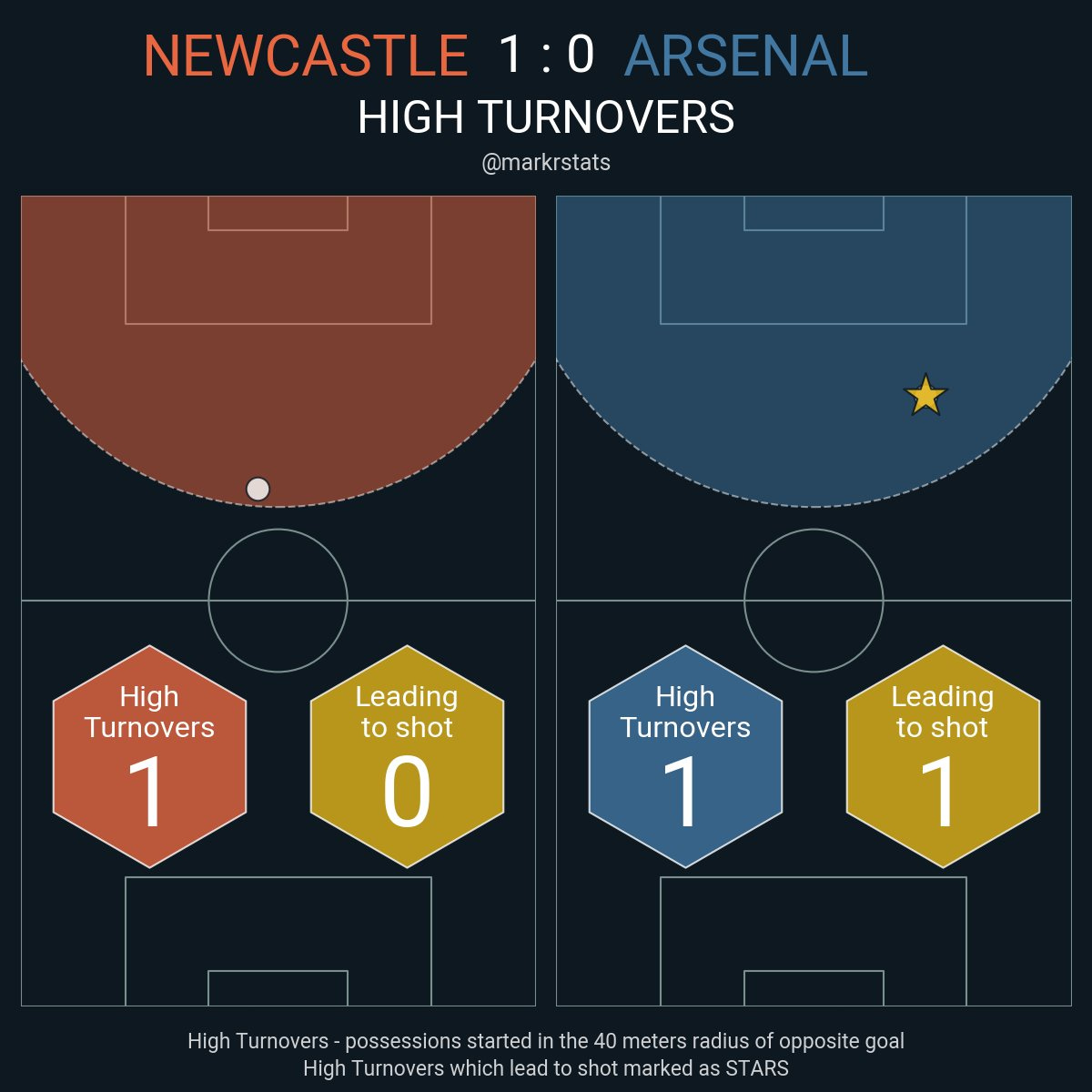









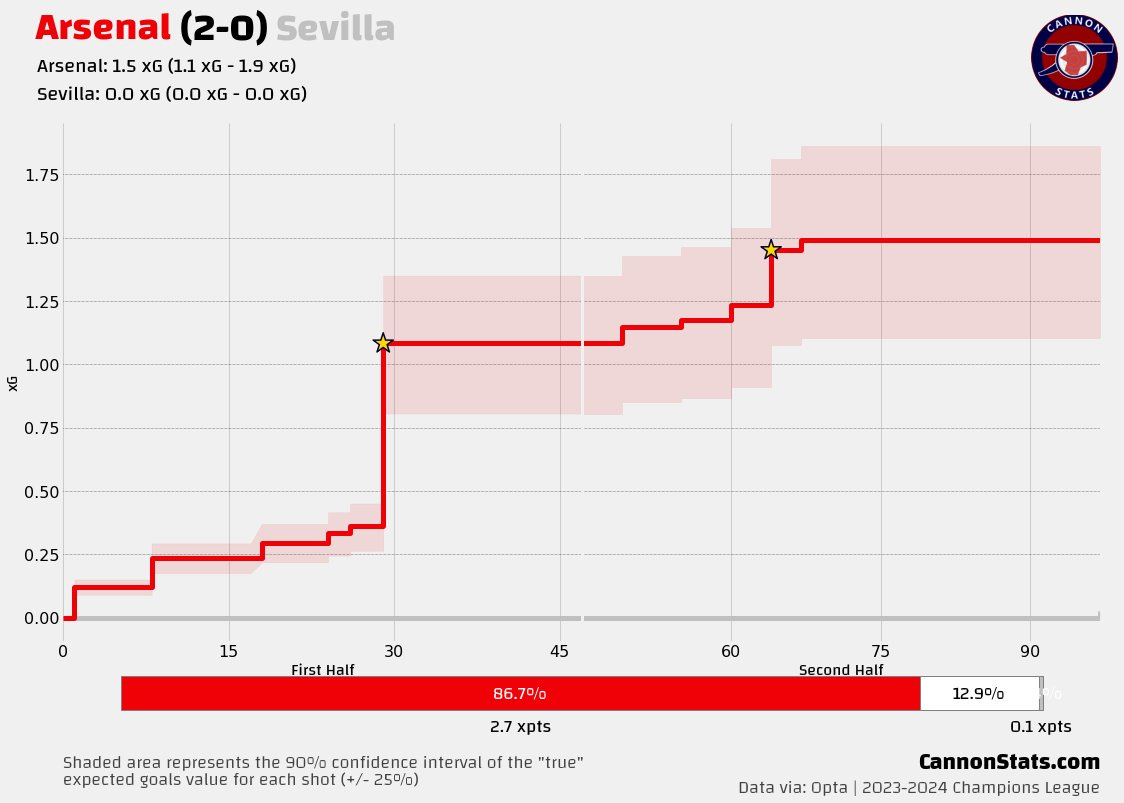
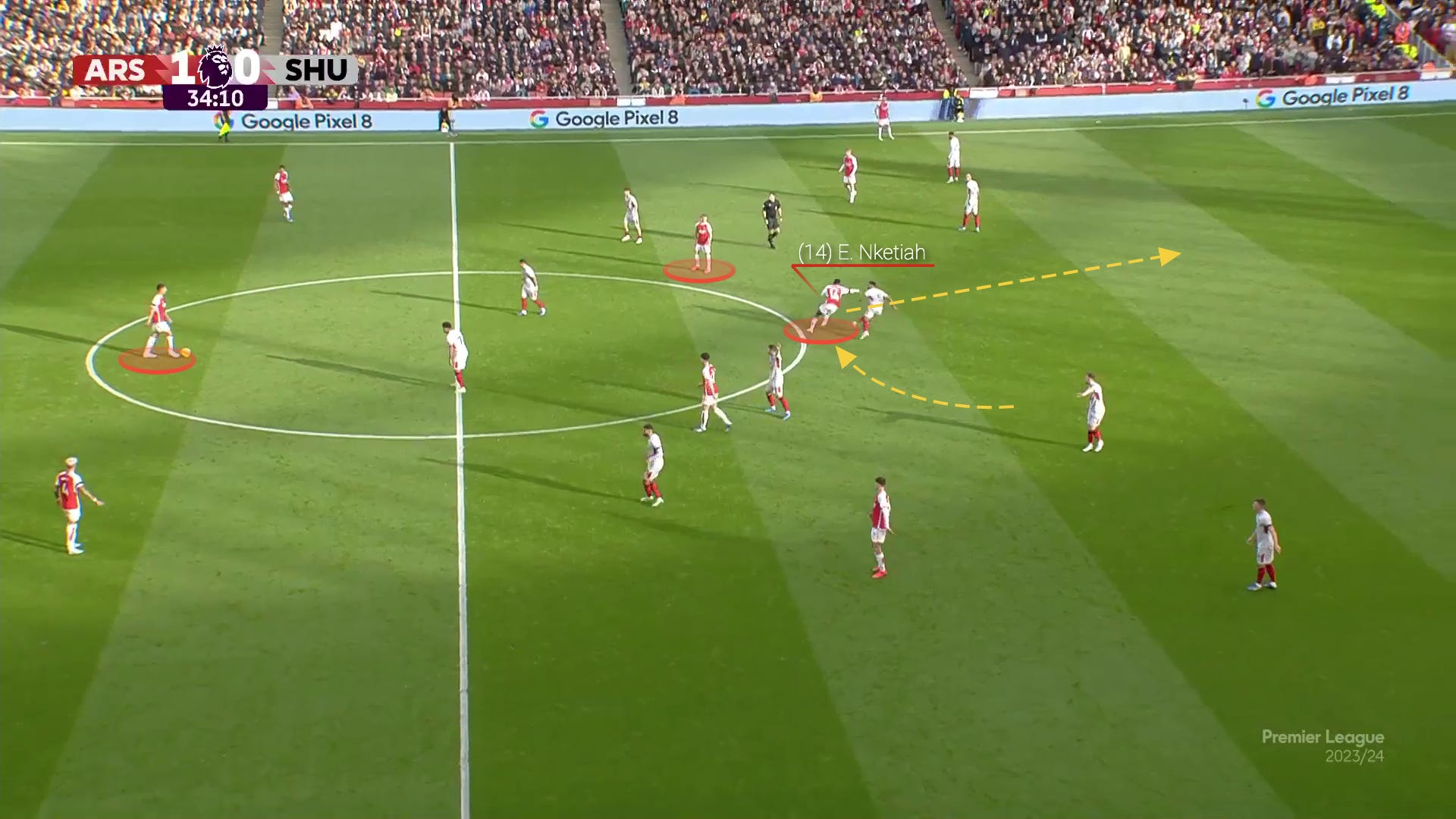






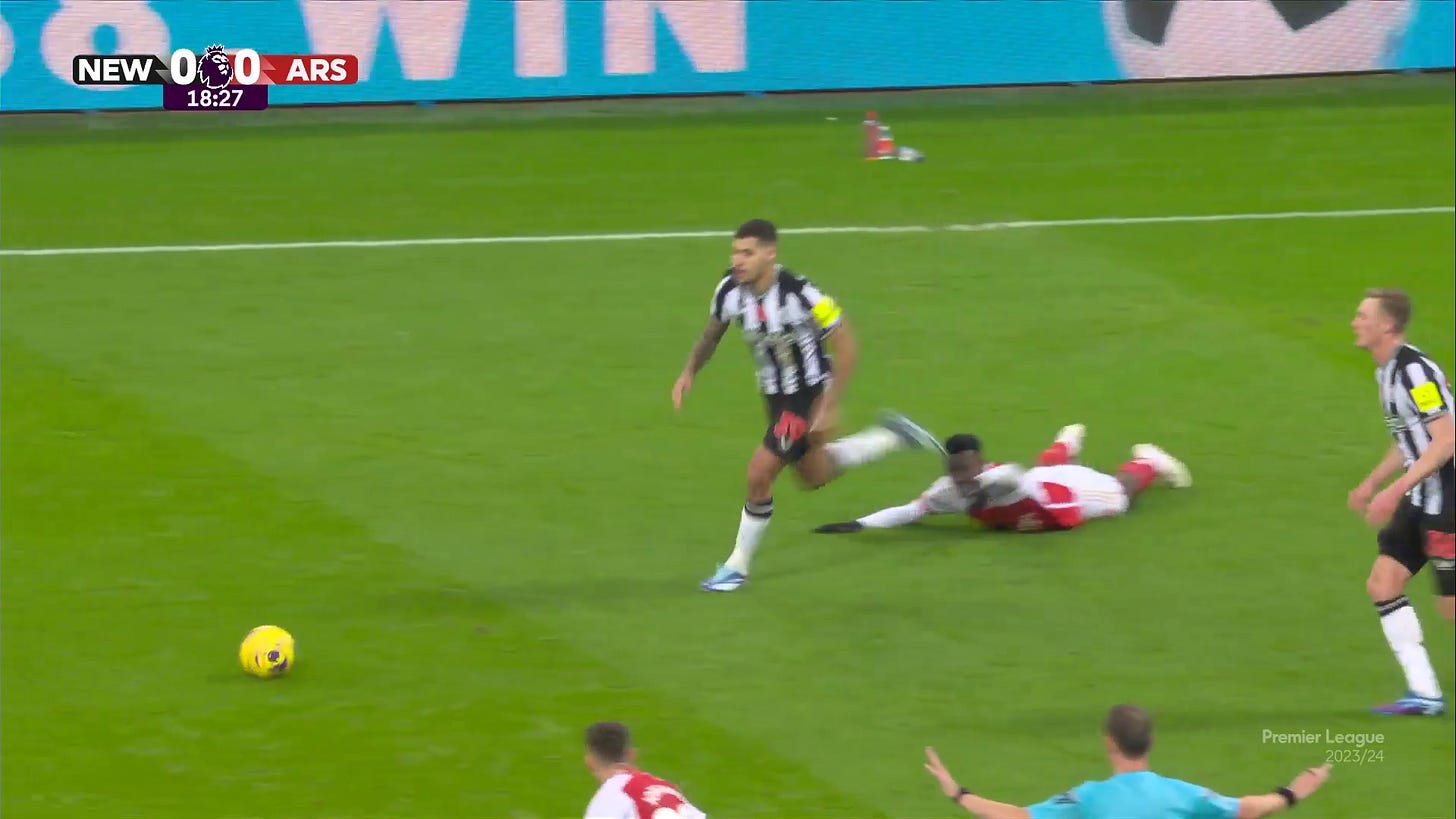
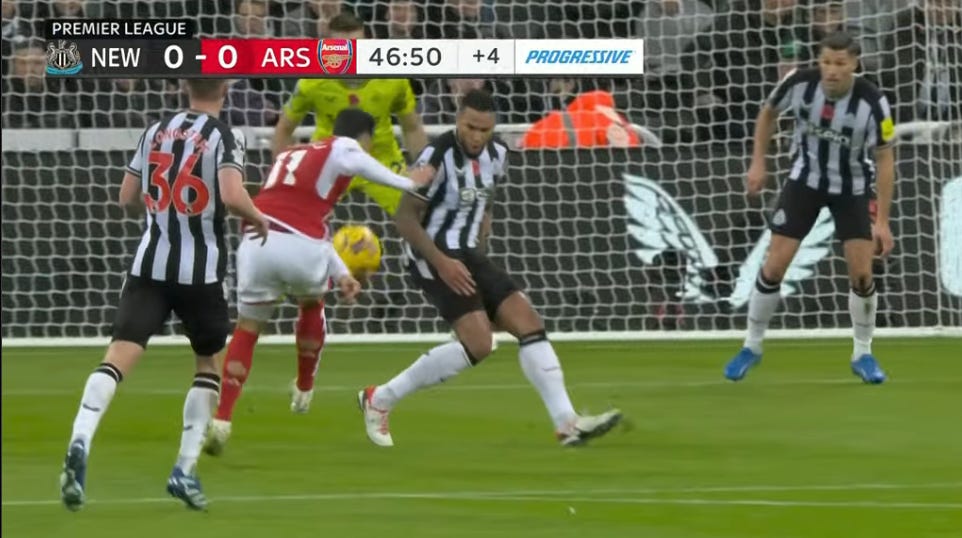







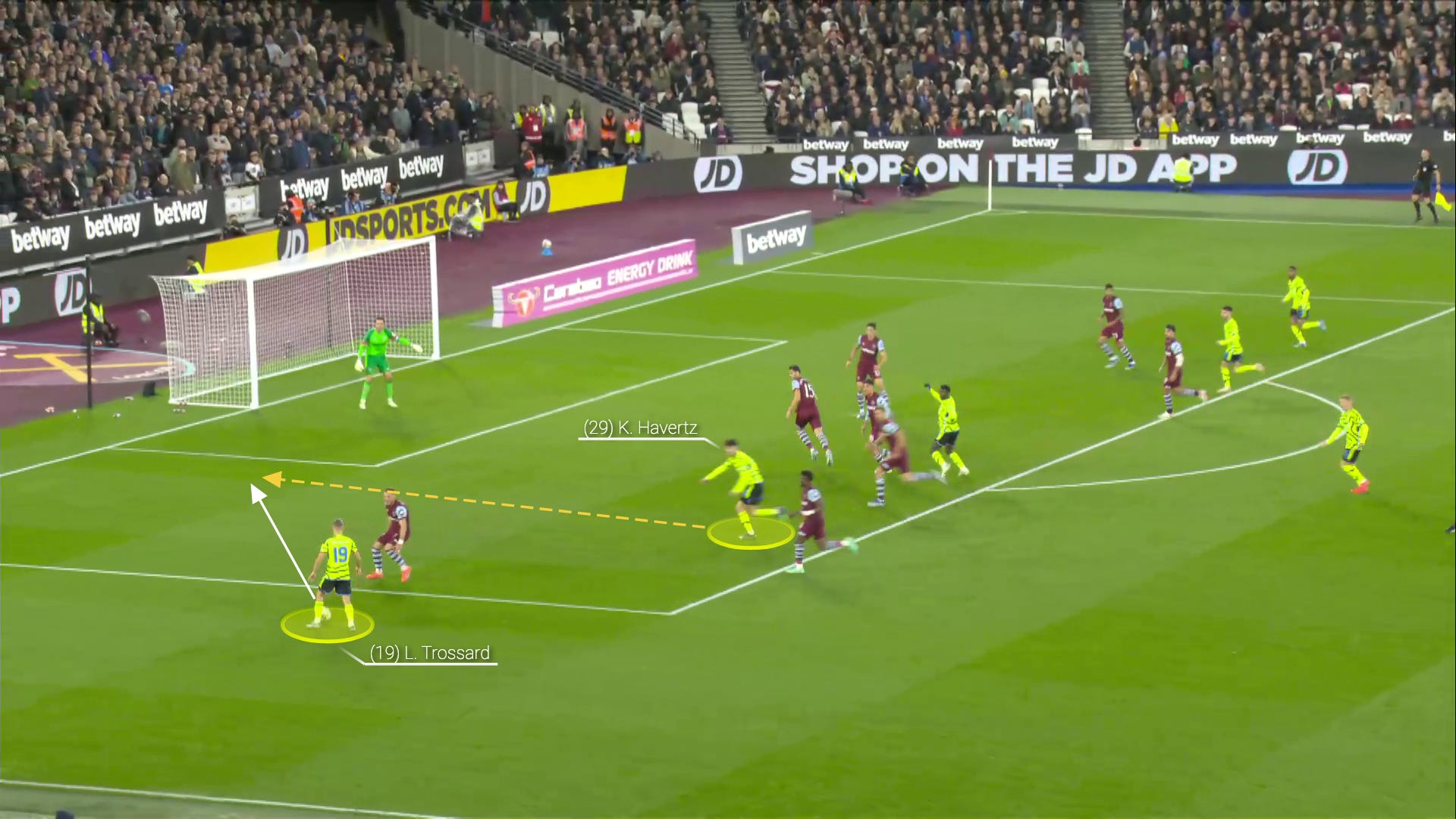
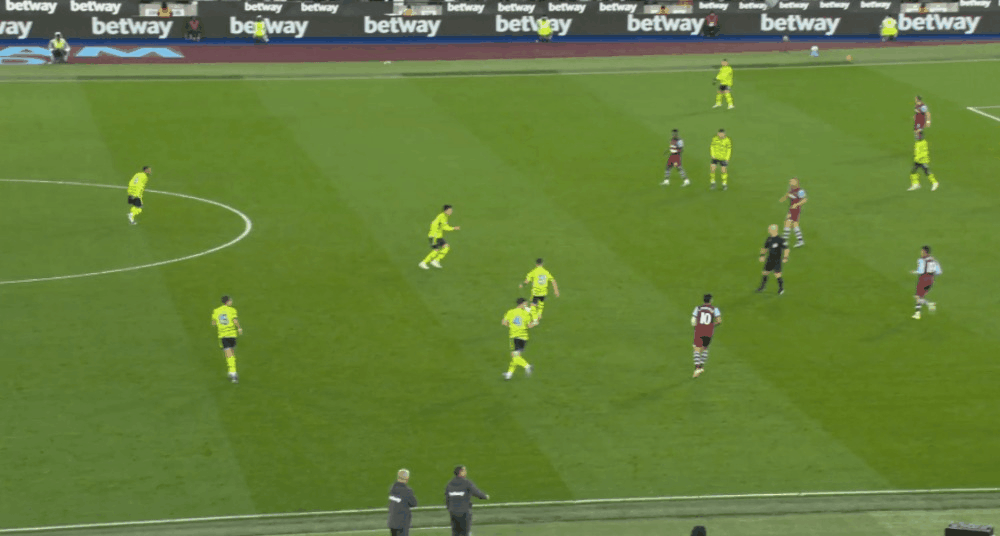
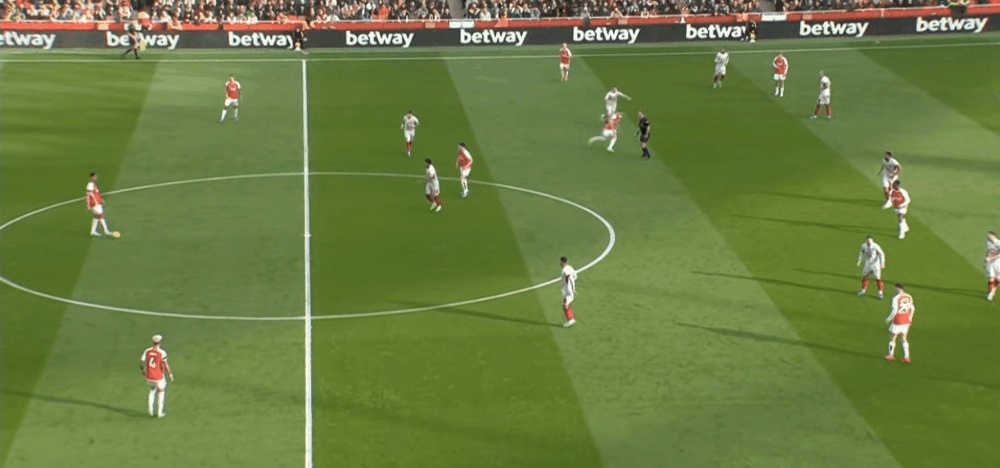

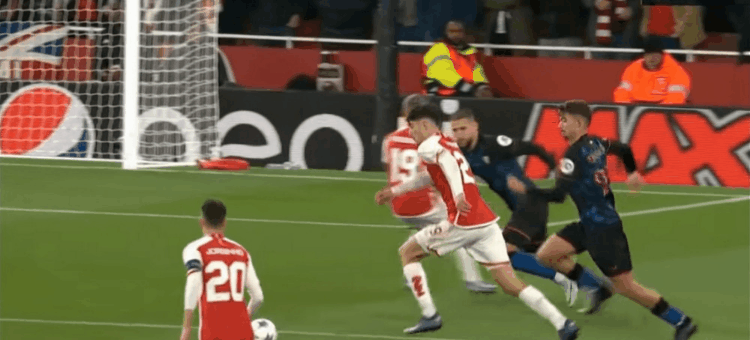


I forgot to turn the comments on. My bad. They're on now. As you can tell.
I really appreciate the thought and detail of this article. That insipid comment on Sky (Newcastle wanted it more) had me screaming at the tv and I am glad you picked up on that as well. Overall, Arteta is re-tooling on the fly and it is fascinating to watch it happen.